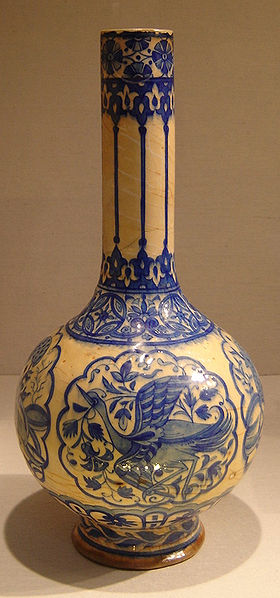Underglaze is a method of decorating pottery in which painted decoration is applied to the surface before it is covered with a transparent ceramic glaze and fired in a kiln. Because the glaze subsequently covers it, such decoration is completely durable, and it also allows the production of pottery with a surface that has a uniform sheen. Underglaze decoration uses pigments derived from oxides which fuse with the glaze when the piece is fired in a kiln. It is also a cheaper method, as only a single firing is needed, whereas overglaze decoration requires a second firing at a lower temperature.
Japanese porcelain Hirado ware paperweight with chrysanthemums and plum blossoms, underglaze blue and brown, 19th-century
Dish with cypress, Turkey, Iznik, c. 1575, underglaze-painted stonepaste – Royal Ontario Museum – DSC04735
Chinese porcelain dish with the typical Ming underglaze blue on white porcelain, Xuande Reign 1426–1435, Ming
Transfer printed plate using two transfers, puce and green, c. 1830, Staffordshire pottery, Enoch Wood & Co.
Ceramic glaze, or simply glaze, is a glassy coating on ceramics. It is used for decoration, to ensure the item is impermeable to liquids and to minimise the adherence of pollutants.
Composite body, painted, and glazed bottle. Iran, 16th century (Metropolitan Museum of Art)
Detail of dripping rice-straw ash glaze (top), Japan, 1852
İznik tiles in the Enderûn Library, Topkapi Palace, Istanbul
Sancai coloured lead-glazes in a Tang dynasty tomb guardian.








